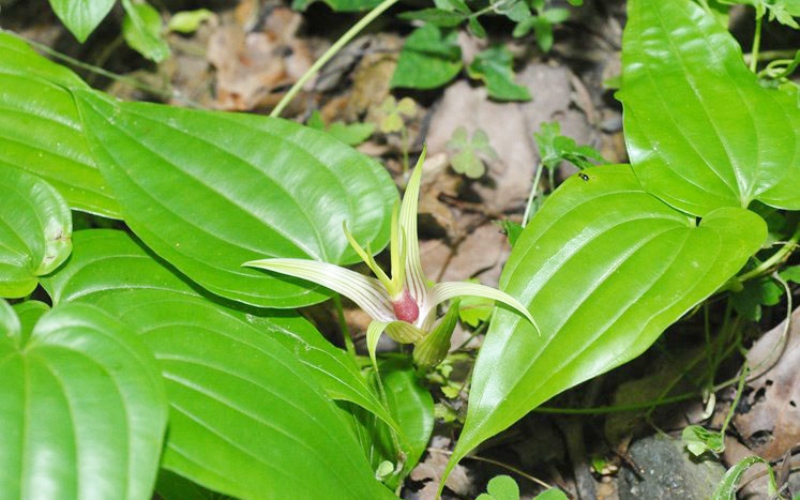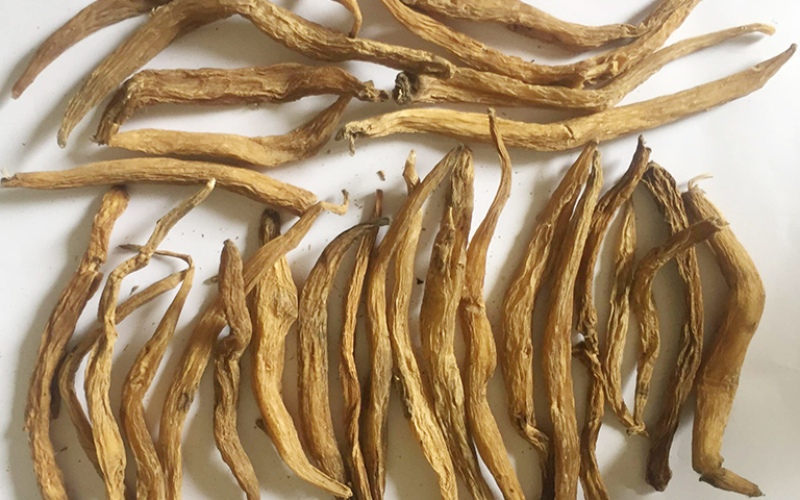Have you ever heard of Stemona tuberosa? This wild-growing vine is native to the mountainous regions of northern Vietnam. Stemona tuberosa, also known as Chinese stemonaceae, has numerous health benefits and is used to treat conditions such as chronic bronchitis, persistent coughs, pinworms, and scabies. However, not many people are aware of its existence and usage. Let’s explore the fascinating world of this medicinal plant and uncover its numerous benefits!
1 What is Stemona tuberosa?
Stemona tuberosa, commonly known as Chinese stemonaceae, also goes by the names dây ba mươi (meaning “thirty-root vine”), dây đẹt ác, and bách nãi in Vietnamese. Its scientific name is Stemona tuberosa Lour.
Stemona tuberosa is a climbing vine with a smooth surface and small, elongated leaves that can grow up to 10 cm long. The leaves grow in an opposite arrangement, with prominent veins running from the base to the tip, clearly visible on the leaf surface.
The plant blooms in the summer, producing red or yellow flowers that alternate with the leaves. The flower stalks are 2-4 cm long.
 Stemona tuberosa is a climbing vine with a creeping root system
Stemona tuberosa is a climbing vine with a creeping root system
As the name dây ba mươi suggests, Stemona tuberosa has a clustered root system with approximately 30 tubers. These tubers can grow up to 6-12 cm in length, with a swollen middle portion that tapers towards the ends. The roots are white to yellowish or grayish-yellow, emitting a fragrant aroma and feeling hard, firm, and crisp to the touch, with a slightly sweet and bitter taste.
2 Where is Stemona tuberosa typically found?
Stemona tuberosa thrives in tropical and subtropical climates and prefers moist, sunny environments, although it can tolerate some shade. In Vietnam, it is commonly found growing wild in the mountainous regions of the Northwest. You can spot it near streams, forest edges, limestone cliffs, and areas with moderate shade.
 Stemona tuberosa thrives in moist, sunny environments
Stemona tuberosa thrives in moist, sunny environments
3 How to properly harvest Stemona tuberosa for medicinal use
The roots are the most important part of the plant for medicinal purposes. Older plants tend to have larger, longer, and more fleshy tubers. Additionally, the roots of older plants are believed to have higher nutritional and medicinal value.
 Harvesting the tubers of Stemona tuberosa
Harvesting the tubers of Stemona tuberosa
The ideal time to harvest Stemona tuberosa is late autumn to early winter, or early spring before new shoots appear.
4 The amazing health benefits of Stemona tuberosa
According to Doctor Nguyen Thuong Hanh from the website Hello Bac Si, Stemona tuberosa has remarkable health benefits, especially in treating respiratory conditions such as cough and bronchitis. Additionally, it is effective against parasitic infections and skin conditions like urticaria, ulcers, and itching.
Stemona tuberosa for chronic cough and bronchitis
- Treating cough and fever in children: Combine 30g each of Stemona tuberosa, Bối mẫu, Cát căn, and Thạch cao, and grind into a powder. Administer 12g of this powder, mixed with a small amount of honey, twice a day to reduce fever and alleviate cough.
- Relieving persistent cough: Use 80g of Stemona tuberosa roots, crush and squeeze out the juice, and reduce it to a thick, sticky consistency. Take one teaspoon of this concentrate, diluted in water, three times a day.
- Treating excessive coughing: Grind the Stemona tuberosa roots into a fine powder or use the entire plant, crushing and squeezing out the juice. Mix this with honey and cook until it forms a thick concentrate. Take a small amount diluted in water and swallow slowly, allowing 15 minutes for absorption.
 Dried Stemona tuberosa roots can be used to treat coughs
Dried Stemona tuberosa roots can be used to treat coughs
Stemona tuberosa for parasite elimination and insect control
- Relieving abdominal pain caused by foodborne parasites: Cook the roots of Stemona tuberosa into a thick concentrate and dilute with water. Drink this once or twice a day before meals to prevent and treat intestinal parasites.
- Parasitic worm expulsion: Refrain from eating for three hours before performing a worm expulsion, preferably first thing in the morning. Use 500g of Stemona tuberosa powder mixed with 200g of Vaseline to create an ointment and apply it to the anus.
 Stemona tuberosa is an effective remedy against intestinal parasites
Stemona tuberosa is an effective remedy against intestinal parasites
Stemona tuberosa for skin conditions such as urticaria, ulcers, and itching
Take fresh Stemona tuberosa roots, clean and slice them thinly, and rub them on the affected area, or crush and extract the juice and apply it topically to the lesion 5-6 times a day.
5 Precautions when using Stemona tuberosa
- Look for Stemona tuberosa roots that are still attached in a cluster of 30 tubers and avoid buying individual roots.
- Choose roots that are intact and free from cracks or resin leakage, as this indicates a loss of medicinal properties.
- For dried roots, select those with a uniform light color, free from black spots or mold.
- Purchase Stemona tuberosa from reputable and well-known sources. Avoid small, obscure shops that cannot provide clear information about the origin of the herb.
- Do not overuse Stemona tuberosa remedies. It is recommended to use a small amount and consume it before meals. Excessive consumption of Stemona tuberosa can lead to poisoning, causing numbness, vomiting, respiratory difficulties, fatigue, and even death.
- In case of mild poisoning, consume ginger juice or ginger tea mixed with warm water. If symptoms persist or worsen, seek immediate medical attention.
 Precautions when using Stemona tuberosa
Precautions when using Stemona tuberosa
In conclusion, Stemona tuberosa is a fascinating medicinal plant with a wide range of health benefits. While it offers numerous advantages, it is important to use it wisely and in moderation. Always consult a healthcare professional before using any herbal remedy to ensure safety and effectiveness.



































